April 30, 2014
Les Mamelles de Tirésias in San Francisco
But it has been raining a bit in San Francisco, and global warming might even make San Francisco wetter rather than dryer. All this took a bit of the edge off this far-fetched conglomeration of an opera within an opera within a commentary. The good news is that we heard some very good singing by well-trained young artists, and there were some snappy performances as well. Not to forget a quite capable little orchestra in a real pit in a real and indeed fine theater, the Lam Research Theater.
San Francisco has long been in need of an additional opera company to explore vast expanses of the repertory left untouched by the heroic scope of War Memorial Opera House. The 750 seat Lam Research Theater offers a potential home to such an opera company, and maybe it is Opera Parallèle, a venture of conductor Nicole Paiement and stage director Brian Staufenbiel, who have mustered a couple of productions each year since 2010, some of them in this fine theater.
This sally onto the Lam Research Theater stage was a meager production — a too real, quite forlorn 22 foot, vintage cabin cruiser put up on wheels and clumsily pulled around the stage. There was no context for the boat, like a parched earth ground or like denuded hills surround, though there were some meager gaseous aurora borealis lighting effects that flickered faintly from time to time that maybe were drought related.
The little, and it is conceptually and musically inconsequential, Mahagonny did not hold together visually or musically on the open, blank stage and the singers were simply too singerly, their elegance a poor substitution for the Weill/Brecht intended grit. Mme. Paiement’s orchestra was without edge and the maestra’s tempos felt leaden indeed.
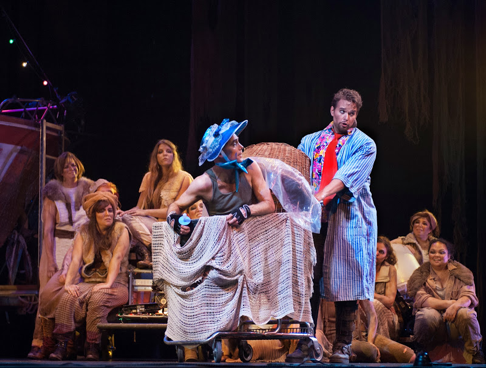
Glenn as The Boy, Gabriel Preisser as The Husband in Les Mamelles de Tirésias. Photo by Steve DiBartolomeo, Westside Studio Image
But it all picked up splendidly when the evening morphed into the Poulenc boulevard musical, Les Mamelles de Tirésias intended to titillate and distract the post WWII Parisian public. To be sure the “advanced” social ideals seemed a bit overworked in long-emancipated San Francisco. Fortunately director Staufenbiel did not take the issues too seriously having transformed the piece into I pagliacci (a commedia dell’arte troupe descends on a backward village) here Weill's singers come upon a camp of refuges from drought stricken village somewhere on the French Riviera. Except it was on a blank black stage.
The downstage sideways positioned cabin cruiser did work very well in Les Mamelles because it gave many levels for action, and many nooks and crannies for visual surprises. You could forget the off-the-wall concept (at least there was a concept, a concept sorely lacking these days in the War Memorial) and simply enjoy the quite appealing music beautifully played in the pit and sung on the stage.
Baritone Gabriel Preisser brought unusual warmth and charm to the role of the Thérèse’s husband, tenor Thomas Glenn stood out in his Les Mamelles caricatures and more than anyone else approached the tone of the Weill. Bass-baritone Hadleigh Adams brought snap and flair to Les Mamelles’ antagonist, the Constable. The entire cast attests the high level of training behind young American artists, and the accomplishment of these young singers was very pleasurable to behold.
It will be a relief to perceive them as artists of personality someday, hopefully soon, rather than as fine young singers. Perhaps Opera Parallèle can accomplish this with deeper production values.
It was finally a well realized evening, of institutional accomplishment and promise. Off-the-wall is meant as a compliment by the way, forget the unfortunate transition at the end back into the little Mahagonny.
Michael Milenski
Casts and production information:
The Husband: Gabriel Preisser; Therèse/Tirésias: Rachel Schutz; The Constable: Hadleigh Adams; The Director: Daniel Cilli; The Journalist/The Son: Thomas Glenn; The Newspaper Vendor: Renee Rapier; The Bearded Man: Aleksey Bogdanov; The Big Lady: Amber Marsh; The Lady; Suzanne Rivin. Opera Paralléle Orchestra and Chorus with the Resound Ensemble. Conductor: Nicole Paiement; Concept and stage director: Brian Staufenbiel; Production design: Frédéric Boulay; Set design: Dave Dunning; Costume design: Christine Crook; Choreographer: KT Nelson. Lam Research Theater, April 26, 2014.
image=http://www.operatoday.com/Mamelle_1.png
image_description=Mahagonny
product=yes
product_title=Mahagonny/Les Mamelles de Tirésias in San Francisco
product_by=A review by Michael Milenski
product_id=Above: Mahagonny [Photo by Steve DiBartolomeo, Westside Studio Image]
April 26, 2014
A Coffin in Egypt: A Tour-de-Force for von Stade
Foglia who wrote the libretto and directed the opera, also directed the world premiere of the original play.
On April 23, 2014, The Wallis Annenberg Center for the Performing Arts gave the West Coast premiere of Ricky Ian Gordon’s new opera, A Coffin in Egypt. Known as The Wallis, the Beverly Hills complex opened in 2013. Thus, it was the perfect place for an even newer opera. Houston, Texas, audiences saw Gordon’s opera last March and Philadelphia audiences will see it in June. Librettist Leonard Foglia based his elegant and literate text on the late Horton Foote’s play of the same name and the opera has the original play’s dramatic punch. Foglia who wrote the libretto and directed the opera, had directed the world premiere of the original play.
Musically, this is a chamber opera that uses the smallest possible forces: one soloist, a quartet of Gospel Singers, and nine instrumentalists. In this case, the soloist was the world famous mezzo-soprano, Frederica von Stade, who came out of retirement to assume the juicy role that Gordon wrote for her. Myrtle Bledsoe was a rich Texas widow who lived in the tiny hamlet of Egypt, near Wharton, where Horton Foote grew up in the early years of the twentieth century. Wharton is on the east side of the Colorado River, about forty-five miles north of the Gulf of Mexico.
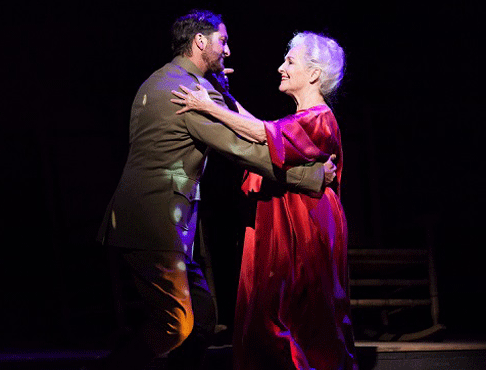 Frederica von Stade as Myrtle Bledsoe and Adam Noble as the Captain
Frederica von Stade as Myrtle Bledsoe and Adam Noble as the Captain
In her ninth decade, Myrtle recounts her life with its many unfulfilled dreams. Although the title speaks of death and Myrtle is old, she is as lively as a firecracker in designer Riccardo Hernández’s bright rose-colored gown. Hernández’s scenery showed flowers on curved surfaces and Brian Nason’s imaginative lighting design added strong colors that enhanced various aspects of the story.
Actually, it is von Stade’s magnetic personality that makes this charming piece come alive. Myrtle recounts her life with her husband, Hunter, and her happiest years abroad with her daughters. She also tells of her husband’s mistresses and the murder with which he was never charged. She can speak freely now because Hunter and her daughters have all preceded her in death. She alone is left to tell the stories, but she knows she will soon join them, in her own coffin, destined to be buried in Egypt. Actors represent the characters of whom she sings. David Matranga was the womanizing Hunter Bledsoe and Adam Noble the handsome Captain Lawson. Carolyn Johnson was Elsie Bledsoe and Cecilia Duarte Jessie Lydell.
The opera is a tour-de-force for mezzo and von Stade’s performance on Wednesday evening is proof that she retired too soon. She was on stage for the full eighty minutes of the opera’s duration, singing almost constantly with well-focused tones. Her voice was always a bit light for a mezzo and on this occasion it had a clarion quality that blended with the woodwinds of conductor Kathleen Kelly’s chamber group. Gordon’s music was very translucent and Kelly’s players brought out his delightful harmonies.
Gordon’s most inventive addition was a Gospel Chorus singing music he composed in the manner of old time Spirituals. For this piece, that addition was sheer genius. Best of all, the singers: soprano Sheryl D. Clansy, alto Laura Elizabeth Patterson, tenor James M. Winslow, and bass Jawan C. M. Jenkins sang in glorious harmonies which formed a delightful contrast to Myrtle’s solo storytelling. Clansy, in particular, has a spectacular voice that should be heard by a wider audience.
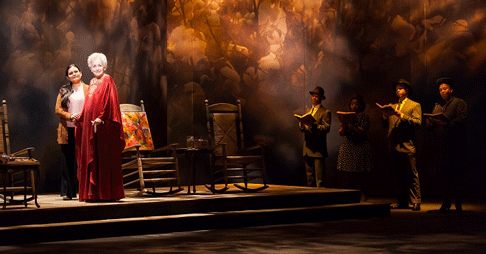 Cecilia Duarte as Jessie, Frederica von Stade as Myrtle, and the Gospel Singers
Cecilia Duarte as Jessie, Frederica von Stade as Myrtle, and the Gospel Singers
A Coffin in Egypt is a new piece that is quickly winning acceptance in the cities where it has been shown. It will be in Philadelphia in June and from there it should go on to the many theaters in cities large and small that need a well put together opera on a small scale.
Maria Nockin
Cast and production information:
Myrtle Bledsoe, Frederica von Stade; Hunter Bledsoe, David Matranga; Elsie/ Clerk, Carolyn Johnson; Jessie Lydell, Cecilia Duarte; Captain Lawson, Adam Noble; Gospel Chorus: Cheryl D. Clansy, Laura Elizabeth Patterson, James M. Winslow, Jawan C. M. Jenkins; Gospel Chorus Director, Bethany Self; Conductor, Kathleen Kelly; Stage Director, Leonard Foglia; Set and Costume Designer, Riccardo Hernández; Lighting Designer, Brian Nason.
image=http://www.operatoday.com/Coffin_in_Egypt_01.gif
image_description=Frederica von Stade as Myrtle Bledsoe [Photo by Lynn Lane]
product=yes
product_title=Ricky Ian Gordon’s New Opera: A Tour-de-Force for Von Stade
product_by=A review by Maria Nockin
product_id=Above: Frederica von Stade as Myrtle Bledsoe
Photos by Lynn Lane
April 25, 2014
Songlives: Henri Duparc
Henri Duparc was born in Paris in 1848 into a wealthy, aristocratic family. He studied piano, and later composition, with César Franck; his earliest compositions, dating from the 1860s, include Six reveries and Feuilles volantes for piano, and a sonata for cello and piano. But in 1885, aged just 37 years old and with a burgeoning career as a successful song-writer ahead of him, Duparc stopped composing. Always highly sensitive and nervous, mental illness which was diagnosed as neurasthenia was accompanied by increasing vision loss, eventually leading to total blindness.
Ever the perfectionist, in later years Duparc destroyed most of his music, leaving few works to posterity; but his seventeen extant songs epitomise the qualities of mélodie: clarity and intensity of expression, diversity of mood, and sophisticated, cultivated union of music and word. Mezzo soprano Sarah Connolly and baritone Hank Neven performed a programme devised by pianist Malcolm Martineau, taking us on a chronological journey through the songs which assured Duparc’s immortality and revealing the astonishing talent which was so sadly curtailed.
Connolly’s sumptuous tone and lyricism are ideally suited to the expressive richness of these songs. In the earliest of them, ‘Chanson Triste’, the gentle, well-shaped melody, reminiscent of Gounod, rested calmly on the warm ripples of the accompaniment, as the poet-speaker bathes in memories of his departed beloved. The voice brightened with a joyful outburst of hope that his inner peace might be restored by such ruminations, and this thread of light suffused the tranquil piano postlude.
‘Romance de Mignon’ was originally suppressed by Duparc as falling short of his exacting standards; it is fairly unsophisticated in terms of its expressive chromaticism but the dark dissonances and the wide expanse of the accompaniment contribute to an operatic rhetoric which Connolly and Martineau dramatically exploited.
‘Au pays où se fait la guerre’ pays melodic homage to Schubert’s ‘Der Erlkönig’. From the ringing opening motif to the angry growl of the final stanza, Martineau’s ever-changing, often strikingly contrapuntal accompaniment lines and textures, created precise moods complementing the word-painting in the vocal line. The song is thought to have been derived from material for a discarded opera; Connolly certainly revealed the range of emotions present in Théophile Gautier’s text, from ecstasy to despair. The growing intensity and sophistication of Duparc’s language and form was evident in ‘L’invitation au voyage’, a setting from Baudelaire’s Fleur du mal, which was composed while the composer was serving in the garrison during the Prussian siege in the winter of 1870—71. The performers masterfully crafted the whole, creating urgent movement forwards; the calm composure of the vision of the loved one’s eyes where dwell ‘order et beauté/ Luxe, calme et volupté’ (order and beauty/ abundance, calm and sensuous delight), subsequently exploded in glittering piano cascades, voice and accompaniment luminous and impassioned.
Connolly opened the second half of the recital with ‘Élégie’ and ‘Extase’ (Rapture), both of which have a Wagnerian flavour. The boldness and colour of Martineau’s accompaniment brought depth of character to the former, while the latter was particularly exquisite, a delicate unfolding of profound emotion. ‘Lamento’, another Gautier setting and dedicated to Fauré, possessed a charming, easy grace; here, Connolly made much of the words, sensitive to Duparc’s sometimes unusual verbal emphases. The mezzo soprano’s gorgeous lower register brought dramatic intensity to ‘Testament’, overcoming the flimsiness of Armand Silvestre’s text.
Unfortunately, baritone Hank Neven could not quite match Connolly’s refinement of technique or interpretation, finding it a challenge to capture Duparc’s expressive register — with its fusion of raw passion and elegant finesse — or the mélodie’s majestic sweep. While the dying final line of ‘Soupir’ (Sigh) was wonderfully tender, the weaknesses in Neven’s pronunciation marred the overall effect, for the expressive ambience depends considerably upon the French-specific features such as elision. ‘Sérénade’ was less tentative, the melodic arcs more robust, but as in ‘Le galop’, with its agitated pounding accompaniment and vigorous vocal line, it all felt a little heavy-handed, and there were some problems with intonation, particularly at the top.
Neven seemed more comfortable with the bold forthrightness of ‘La vague et la cloche’ (The wave and the bell); the low unison of voice and accompaniment — ‘Puis, tout changea … la mer et sa noire mêlée/ Sombrèrent’ (Then everything changed. The sea and its black tumult subsided’) — was chillingly ominous, and above Martineau’s tolling ostinato, the baritone assumed a convincing declamatory mode. And, in the second half ‘Sérénade’ florentine’ and ‘Phidylé’ were also more successful, the former especially lyrical and stylish, its gentle sentiments far from the violence and suffering of many of the other songs.
‘Phidylé’ is perhaps Duparc’s greatest song, and Neven and Martineau’s wonderfully unhurried gradation was enchanting, the piano’s tranquil postlude particularly beautiful. The first half of the evening had ending with Duparc’s rarely sung duet, ‘La fuite’ (Escape), providing an opportunity for the singers to tap their operatic vein; but Neven closed the recital alone, with a sensitive rendition of the composer’s final song, ‘La vie antérieure’ (A previous life), quietly capturing Baudelaire’s yearning and nostalgia.
This was an evening of great interest and delight. The performers consummately confirmed Duparc’s own description of his songs: ‘they come from the heart and speak to the heart’.
Claire Seymour
Performers and programme:
Sarah Connolly, mezzo soprano; Hank Neven, baritone; Malcolm Martineau, piano. Wigmore Hall, London, Wednesday 23rd April 2014.
Duparc: ‘Chanson Triste’, ‘Soupir’, ‘Romance de Mignon’, ‘Sérénade’, ‘Le galop’, ‘Au pays où se fait la guerre’, ‘L’invitation au voyage’, ‘La vague et la cloche’, ‘La fuite’, ‘Élégie’, ‘Extase’, ‘Le manoir de Rosemonde’, ‘Sérénade’ florentine’, ‘Phidylé’, ‘Lamento’, ‘Testament’, ‘La vie antérieure’.
image=http://www.operatoday.com/Henri_Duparc.gif image_description=Henri Duparc product=yes product_title=Songlives: Henri Duparc product_by=A review by Claire Seymour product_id=Above: Henri DuparcApril 23, 2014
La Bohème, Manitoba
Three performances of the quintessentially romantic opera based on Henri Murger’s Scènes de la Vie de Bohème were held April 5 - 11 at Winnipeg’s Centennial Concert Hall.
Canadian opera/theatre director Brian Deedrick, who also helmed MO’s April 2013 production of Aida, once again displayed his clear artistic vision and deft attention to detail, including adding effective bits of stage business to create further textural layering.
Realistic sets by Wolfram Skalicki (on loan from Edmonton Opera), lit by Bill Williams, included a cutaway garret worthy of any starving artist and jaw-dropping Latin Quarter street-café and city park scenes complete with gently falling snow. Maestro Daniel Lipton led the Winnipeg Symphony Orchestra through Puccini’s lushly orchestrated score that teems with one soaring melody after another.
Marking her MO debut, American soprano Danielle Pastin imbued her lead role of Mimì with heart-wrenching pathos, her clear voice and artfully executed phrasing first displayed during tender aria “Mi chiamano Mimì.” As she became increasingly wrought with “consumption,” her voice only grew in luminosity until her final, poignant duet sung with Rodolfo: “Sono andati?”
Rodolfo performed by Eric Fennell (MO debut) often felt eclipsed by the orchestra and rest of the strong cast, his otherwise fine lyric tenor not always fully projecting and perilously close to becoming subsumed during aria “Che gelida manina.” He fared better during ensemble numbers, such as the sparks-flying quartet “Addio dolce svegliare alla mattina!” where the two lead couples contrapuntally play off eacher other.
American tenor Keith Phares (MO debut) delivered a standout performance as smock-wearing artiste Marcello, Rodolfo’s friend and lover of saucy playgirl Musetta. He painted his character with testosterone-fuelled swagger, brooding about love with Rodolfo during duet “O Mimi, tu più non torni.”
The perfectly cast Winnipeg soprano Lara Ciekiewicz first flounced onstage as Musetta with her hapless “mummy” and sugar daddy, Alcindoro (bass-baritone David Watson, doubling as landlord Benoit) before delivering an effervescent “Quando me’n vo’.” The gifted actress embarked on her own emotional trajectory that ends when she reveals a beating heart of gold during the final act.
And the Act’s finale where the choristers join Musetta in her lilting waltz is opera at its most lump-in-the-throat, glorious best.
Bass-baritone Giles Tomkins (MO debut) also crafted a convincing philosopher Colline, who particularly shone during aria “Vecchia zimarra,” as did baritone Peter McGillivray as musician Schaunard. The male ensemble’s camaraderie became palpable as the four flatmates jousted with baguettes and mused about life, love and how they were going to make next month’s rent.
Opera’s calling card is spectacle, and the MO Chorus (prepared by Tadeusz Biernacki), Children’s Chorus (Carolyn Boyes) augmented by a motley crew of ragtag supernumeraries created enthralling eye candy during Act 2’s street scene, including their lively “Aranci, datteri! Caldi i marroni!” Gendarmerie, street urchins, a marching band, Pierrot character and an all-too-fleeting appearance by toy vendor Parpignol (reprised by Winnipeg’s Peter Klymkiw) added to the full-bore sensory experience that elicited audible gasps from the audience.
Holly Harris
image=http://www.operatoday.com/Boheme_Manitoba.png image_description=La Boheme [Image courtesy of Manitoba Opera] product=yes product_title=La Bohème, Manitoba product_by=A review by Holly Harris product_id=Above image courtesy of Manitoba OperaArizona Opera Presents Don Pasquale in Tucson
Pasquale was an aging movie idol from the silent picture era who had been very famous at one time. In the nineteen fifties, however, he was living in an aging mansion on Sunset Boulevard that was as devoid of color as his old black-and-white films.
Gaetano Donizetti’s Don Pasquale is an opera buffa or comic opera with a libretto by Giovanni Ruffini and the composer based on the text that Angelo Anelli wrote for Stefano Pavesi’s earlier work Ser Marcantonio. In the tradition of opera buffa, the opera makes reference to the stock characters of the Commedia dell'arte. Beginning in the sixteenth century, the Italian Commedia usually involved improvised performances of simple sketches. Actors and actresses were usually professionals and they generally specialized in portraying one particular character. Actually the popularity of the Commedia did much to gain the right to perform on stage professionally for women because men did not portray the female characters. As with the show pictured in Ruggero Leoncavallo’s Pagliacci, most performances took place outdoors on temporary stages with minimal scenery.
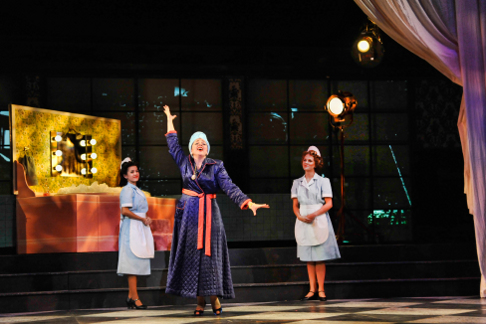 Andrea Shokery as Norina the Hollywood starlet [Photo by Ed Flores]
Andrea Shokery as Norina the Hollywood starlet [Photo by Ed Flores]
The characters of the Commedia usually represented common social types such as foolish old men, handsome young lovers, beautiful, calculating young women, and devious intermediaries. In Don Pasquale the title character is a foolish old man, Ernesto a handsome lover, Malatesta a wily intermediary, and Norina a beautiful young woman who is in on Malatesta's scheme. The use of a false notary is a common operatic device also found in Mozart’s Cosi fan tutte.
On April 12, 2014, Arizona Opera opened its series of performances of this opera in Tucson instead of Phoenix and there we enjoyed the slower tempo of Southern Arizona. Chuck Hudson’s production of Don Pasquale combined Commedia dell’arte with Hollywood movie history. Pasquale was an aging movie idol from the silent picture era who had been very famous at one time. In the nineteen fifties, however, he was living in an aging mansion on Sunset Boulevard that was as devoid of color as his old black-and-white films. His ward and nephew, Ernesto, having refused to accept an arranged marriage, proclaimed his love for an attractive Hollywood starlet named Norina. Therefore, the outraged Pasquale decided to disinherit the young man and beget his own heirs. To do this he needs a wife, however, so he calls on a family friend, Malatesta, to help him find one.
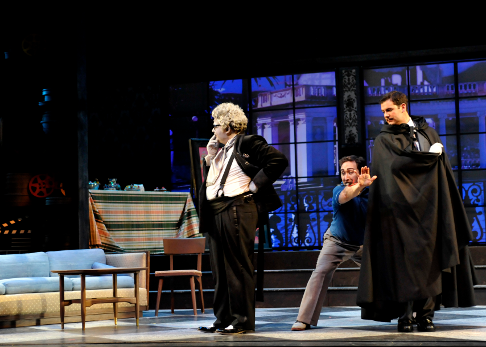 Craig Colclough as Don Pasquale, David Margulis as Ernesto, and Chris Carr as Malatesta [Photo by Ed Flores]
Craig Colclough as Don Pasquale, David Margulis as Ernesto, and Chris Carr as Malatesta [Photo by Ed Flores]
From there the plot of this production differed very little from traditional renditions of the opera. Craig Colclough was a thoroughly amusing, fast singing Don who eventually laughed at his own foibles. He was the only singing member of the cast who was not a member of Arizona Opera’s Marion Roose Pullin Studio. For the young Studio Artists this was their time to shine and that is exactly what they did. Andrea Shokery was a hysterically funny Norina who sang accurately while kicking up her heels. The sound of David Margulis’s tenor voice was honey for the ears. The audience knew Ernesto would get the girl in the end, but they suffered with him on the many occasions when comic obstacles got in his way. Baritone Chris Carr, who can spit tonally accurate patter like a machine gun, was a contentious Malatesta who enjoyed stirring up a hornet’s nest. As the false notary, Calvin Griffin amused us with his antics.
Conductor Gary Wedow used rubato to readjust some of the rhythms of the overture, and with the small orchestra playing this performance, it tended to change some of the music’s free flowing melodies. Henri Venanzi’s chorus, many of whom were dressed as specific old time Hollywood stars, sang in exquisite harmony while they posed for cameras. Wearing Kathleen Trott’s costumes, the audience recognized the characters immediately. One of the most amusing portrayals was silent. Ian Christiansen, the Don's fascinating, formally dressed Manservant, seemed to glide rather than walk across the room as he added to the old fashioned glamor of the mansion. This was a well thought out updating and it worked to make this nineteenth century opera a great piece of twenty-first century entertainment.
Maria Nockin
Cast and production information:
Don Pasquale, Craig Colclough; Norina, Andrea Shokery; Ernesto, David Margulis, Malatesta, Chris Carr; Notary, Calvin Griffin; Manservant, Ian Christiansen; Cook, Diane Goullard; House Boy, Samuel Slater; Maid, Ruth Sager; Conductor, Gary Wedow; Stage Director, Chuck Hudson; Chorus Master, Henri Venanzi; Costume Designer, Kathleen Trott; Lighting and Projection Designer, Douglas Provost; Set Designer, Peter Nolle.
image=http://www.operatoday.com/Andrea_Shokery.png
image_description=Andrea Shokery [Photo by Robert Hayes]
product=yes
product_title=Arizona Opera Presents Don Pasquale in Tucson
product_by=A review by Maria Nockin
product_id=Above: Andrea Shokery [Photo by Robert Hayes]
April 15, 2014
Will Don Quichotte Be the Last Production at San Diego Opera?
Is it not equally mad to let a great opera company like San Diego Opera die when it could live on with different leadership?
On Saturday night, April 5, 2014, San Diego Opera (SDO) presented what may be its last production, a revival of Jules Massenet’s Don Quichotte. On March 20, General Director Ian Campbell announced that the company would “shut down with dignity” on April 14. SDO is not out of money, but it can no longer afford the deluxe productions it has staged in the past. The move was a total surprise to the employees, but only one of the board members voted against the closing. At the Saturday evening performance of the Massenet opera, Campbell was booed unmercifully when he attempted to speak to the audience. Since his announcement of the closure, almost twenty-one thousand SDO fans have signed a petition to keep opera in San Diego. It can be found here. The Save the Opera Campaign can be found online here.
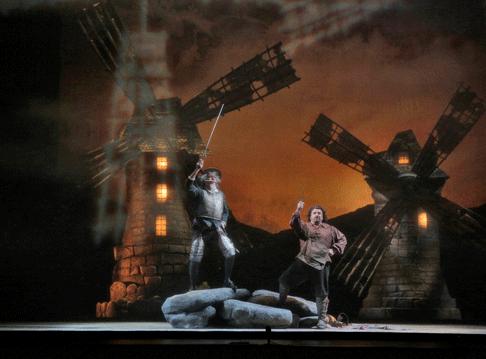 Don Quixote and Sancho Panza fight the giant windmills.
Don Quixote and Sancho Panza fight the giant windmills.
Don Quichotte (Don Quixote) is an opera in five acts that Jules Massenet composed to a French libretto by Henri Caïn. Although Massenet's comédie-héroïque relates to the great Spanish novel by Miguel de Cervantes, it is closer to Jacques Le Lorrain’s play Le Chevalier de la Longue Figure, which was first seen in Paris in 1904. The opera, written in 1909 for the Russian bass Feodor Chaliapin, was first performed early the following year at the Opéra de Monte Carlo. The composer may have also thought of himself as a Don Quixote, because at the age of sixty-seven, he was in love with his twenty-seven year old Dulcinea, Lucy Arbell.
Don Quichotte is a vehicle for a charismatic singer with a low voice. Italian bass Ferruccio Furlanetto is one of the truly great artists of our time and an opportunity to enjoy his interpretation of the character created by Cervantes is most welcome, even if the circumstances surrounding it are painful. In 2009, the opera was first staged in San Diego for Furlanetto. Both then and in 2014, his fully engaged character portrayal, his personal magnetism, and above all his glorious singing made the audience fall in love with the madly idealistic knight. San Diego has a large Spanish-speaking population and they were particularly in evidence for this French take on an author with whose work they are most familiar.
Keturah Stickann’s traditional production followed both Caïn’s libretto and Massenet’s music with great care, but added twenty-first century lighting and stagecraft. She told her story in a most creative manner and showed applicable quotations from the original Cervantes work in translation before each scene. The Windmill Scene was particularly memorable because the music seems to be turning the huge blades as they emerged from the fog. Conductor Karen Keltner, a specialist in French music, was at her best as she gave us a musically apt description of the mind of the ingenious gentleman from La Mancha. Missy West’s exquisite costumes and Kristina Cobarrubia’s colorful Flamenco dances added visual excitement to the production. The sets by Ralph Funicello combined with Marie Barrett’s lighting to show the bare bones landscape of rural Spain.
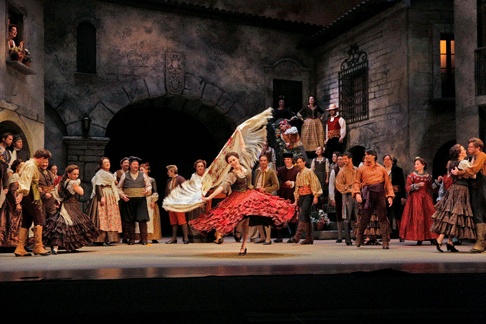 Flamenco Dancing in Don Quichotte
Flamenco Dancing in Don Quichotte
Eduardo Chama’s Sancho Panza was an amusing peasant who really cared for his master. Vocally, he seems to have lost some resonance since 2009, but his able portrayal of the character made up for it. Anke Vondung was a flirtatious but innately practical Dulcinea who sang with a chocolate cream voice. Hervé Blanquart was a frightening head bandit while Chad Frisque, Michael Blinco, Anthony Ballard, and Joseph Grienenberger were mean-looking thugs. Others in the cast who added much to the production as a whole were Joel Sorenson as Rodriguez, Simeon Esper as Juan, Michaëla Oeste as Pedro, and Susannah Biller as Garcias. Choral music is often important in French opera and this work is no different. Charles F. Prestinari’s group sang with precision as they floated their delicious harmonies out into the auditorium. It’s sad to think that they and their instrumental colleagues may have much less work after the end of this season.
Maria Nockin
Cast and production information:
Rodriguez, Joel Sorenson; Juan, Simeon Esper; Pedro, Michaëla Oeste; Garcias, Susannah Biller; Dulcinea, Anke Vondung; Don Quixote, Ferruccio Furlanetto; Sancho Panza, Eduardo Chama; Ténébrun Chief Bandit, Hervé Blanquart; Conductor, Karen Keltner; Director Keturah Stickann; Choreographer, Kristine Cobarrubia; Scenic design, Ralph Funicello; Costume design, Missy West; Lighting design, Marie Barrett; Chorus Master, Charles F. Prestinari; Supertitles, Ian Campbell.
image=http://www.operatoday.com/qix_0335a.gif
image_description=Anke Vondung as Dulcinea and Ferruccio Furlanetto as Don Quixote [Photo by Ken Howard]
product=yes
product_title=Will Don Quichotte Be the Last Production at San Diego Opera?
product_by=A review by Maria Nockin
product_id=Above: Anke Vondung as Dulcinea and Ferruccio Furlanetto as Don Quixote
Photos by Ken Howard
April 13, 2014
Gound Faust - Calleja and Terfel, Royal Opera House London
The opera starts in darkness: Faust knows all about the world from books, but hasn't lived. Maurizio Benini's tempi were slow, suggesting that Faust is perhaps on the point of death when the pastoral theme bursts into the overture like a breath of Spring. When Calleja cried "Rein!", his anguish was heartfelt. As the youthful Faust, Calleja is much more in his element. His natural exuberance makes his Faust cocky rather than intellectual, but that's a perfectly valid interpretation. When Calleja sang "Salut! demeure chaste et pur" he held the spectacular long note so fluidly, the audience went into rapture. Calleja's Faust is an endearingh Italian (Maltese) wide boy, oozing charm. His rapport with the Margeurite of the evening, Alexia Voulgaridou, was good: they were singing together rather than at each other. There's a difference.
Bryn Terfel created Méphistophélès for this production ten years ago, so it was big news when he substituted for another singer at short notice. Terfel is always a force to be reckoned with, even when forcefulness dominates his singing. Méphistophélès gets away with things because he's sly. The delicate background of pizzicato around the part suggest half-glimpsed flashes of hellfire. Rather more cunning on Terfel's part might have been more in character. Terfel's Méphistophélès and Calleja's Faust don't mesh together well, though both singers are masters at working an audience. Terfel's performance this time round was interesting because it showed just how "Gallic" Gounod's Méphistophélès is, in contrast to Goethe's original, and to Russian manifestations, Think Chaliapin. When René Pape sang the part in 2011, the urbane sophistication he brought to the part made it truly sinister.
Alexia Voulgaridou has sung Marguerite many times. As soon as she began singing, her experience showed. She may not be as high profile as Sonya Yoncheva, who has appeared at the Met, with whom she shares the role, but she inhabits the role with great conviction. In her Jewel Song, her rich timbre evoked the sensuality underlying the purity in Marguerite's personality. Voulgaridou is physically very small, but energetic, suggesting the innate strength in the role. The revival director, Bruno Ravella, has dispensed with the silly blonde wig that made Angela Gheorghiu look wrong in 2011. It's the singing that counts, and most of the good ones these days have Latin complexions, perfectly right for a French heroine.
Simon Keenlyside is a perennial House favourite, but here his Valentin seemed underdeveloped. He has the notes but pushes them a little too hard, though his "death aria" was evenly paced an d well presented. Keenlyside's Valentin could have been the brother of Terfel's Méphistophélès. In 2011, Dmitri Hvorostovsky intimated that there's more to Valentin than the libretto alone might indicate. Renata Pokupić's Siebel was spirited. This is an unusual part wihich could be shaped well by someone with Pokupić's individuality: perhaps she'll make it a signature role. Jihoon Kim sang Wagner. Next season he will become a company principal, deservedly so, as he's very good. Diana Montague sang Marthe.
The designs in this production, by Charles Edwards and his team, also reference the "Frenchness" of Gounod's idiom. In the cathedral scene, Marguerite prays before an ornate Baroque sculpture, from which Méphistophélès emerges. In modern, secular times the idea of sacrilege might not be as shocking as it was in 19th century France, so this staging is an excellent way into the deeper levels of meaning in the opera. The military choruses, for example, would have resonated with audiences for whom Napoleon III and the Crimean War were topical. Marguerite's predicament, too, highlights the hypocrisy of a world in which one unmarried mother s condemned while the image of another is revered. The Walpurgis Night ballet is staged in the context of the Paris Opéra,, where patrons lust for young dancers, just as Faust fancied Marguerite. The choreography, originally by Michael Keegan-Dolan and revived by Daphne Strothmann, was brilliantly executed - the male principal Eric Underwood was particularly expressive, his physical agility underlining the erotic undercurrent that runs through the whole opera.
Anne Ozorio
image=
image_description=
product=yes
product_title=Charles Gounod Faust, Royal Opera House, London 11th April 2014
product_by=A review by Anne Ozorio
product_id=
April 10, 2014
Syracuse Opera’s Porgy and Bess
Got Plenty O’ Plenty
Syracuse Opera returned to the grandeur of the 2,117-seat Crouse Hinds Theater Sunday for its 2013-14 season-closing production of an adaptation of Gershwin’s theatrical masterpiece, Porgy and Bess. (The company’s two earlier chamber-sized productions, The Tragedy of Carmen and Maria de Buenos Aires, were housed at the more intimate Carrier Theater.)
Proponents of The Gershwins’ Porgy and Bess champion the truncated version as a vehicle better suited to live theater, which may be true — although purists are likely to disagree. But judging from the over-the-top ovation by the near-capacity crowd at curtain call, I’d say this version appears to be perfectly sufficient. Moreover, Sunday’s performance was, by any measure, an artistic success.
Syracuse Opera had been publicizing this one-time only event (there was no repeat performance) as a “semi-staged” production. Come curtain time, however, the audience discovered that it ain’t necessarily so. This performance had the look and feel of a full-blown staged production, complete with costumes and stage action. If it didn’t capture the substance of Catfish Row, at least it captured its essence — and soul. Except for the placement of the orchestra at the back half of the stage (instead of in the pit) and a static set that did not change, this was a complete operatic experience. And a handsome one, at that.
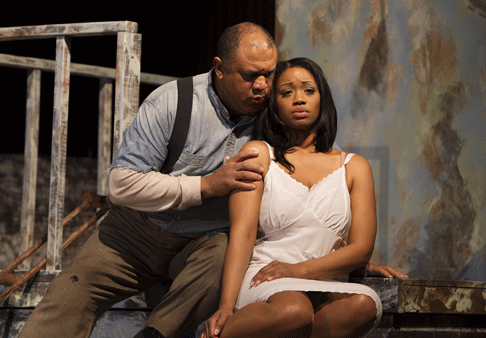
One reason for the success of this production was Syracuse Opera’s decision to engage Hope Clarke, the first African-American to direct and choreograph Porgy and Bess both here and abroad. Clarke’s directorial touches included enlisting the 44-member Syracuse Opera Chorus as active participants in the musical numbers. The chorus, well prepared under the direction of Chorus Master Joseph Downing, swayed, danced and waived their arms high into the air during numbers such as Oh, I can’t sit down — at times resembling a revivalist church gathering. Clarke’s ensemble spirituals and laments were handsomely composed on the stage, and her poignant staging of Robbins’s wake was truly touching.
Another reason for the company’s success was the direction of the singers and instrumentalists by Douglas Kinney Frost. Conducting the orchestra with his back to the singers, Frost — aided by display screens strategically placed at various parts of the stage — managed to juggle competing forces with no major mishaps. (It customarily takes a performance or two to work out the kinks.) Frost had just one shot to get it right — and he did.
Perhaps the single greatest reason for the production’s success was the
quality of the acting and singing. Ironically, it was the supporting roles that
impressed me the most — particularly Michael Redding (Crown), Aundi Marie
Moore (Serena), Brittany Walker (Clara) and Jorell Williams (Jake). The
performances by the principals were strong, but uneven.
Laquita Mitchell is no stranger to the role of Bess, having sung (with Eric
Owens as Porgy) in the 2009 Francesca Zambello production at San Francisco
Opera. Mitchell looked the part from the moment she took stage — drugged out
and slinking across the floor much like the way Maria describes her: a
“liquor guzzlin’ slut.”
Mitchell was in excellent voice throughout the afternoon, using her darkly tinged soprano to great effect in What you want wid Bess, sung while trying to get out of the clutches of the abusive Crown. Mitchell’s acting, however, was less persuasive. She could not project her character’s agonizing ambivalence in choosing between the man who accepts and loves her and Sportin’ Life’s happy dust.
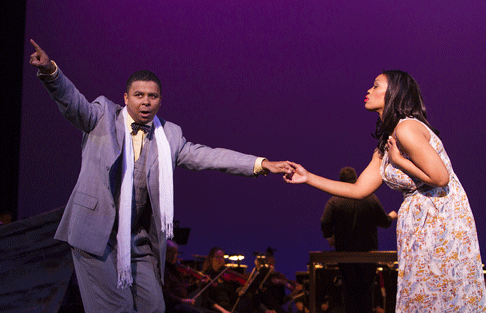
As the proud cripple, Porgy, Gordon Hawkins sang with a hefty baritone that easily projected throughout the large hall. Like Mitchell, Hawkins had performed the role in a Zambello production (Chicago Lyric Opera, 2008). He forged a commanding stage presence from his very first entrance and his acting skills were thoroughly convincing. But Hawkins’s vibrato Sunday was uncomfortably wide — especially when singing in full voice or at the top of his range. This in turn muddied his words and rendered his diction virtually unintelligible, as was evident in his third act lament, Bess, o where's my Bess.
Victor Ryan Robertson fashioned a suitably flamboyant Sportin’ Life, Catfish Row’s friendly neighborhood drug pusher who presses Bess to come with him to Harlem and live the high life. Looking especially unctuous in Costume Designer Jodi Luce’s colorful three-piece brown suit (with ample pockets to hold his stash of happy dust), Robertson tickled the crowd with his cunningly innocent revision of Biblical history in It Ain’t Necessarily So. Robertson’s pleasant tenor, though not strong, was always enjoyable. He was the only singer whose diction remained crystal clear throughout the performance.
Baritone Michael Redding as the villainous Crown gave a standout performance in this production. The Atlanta native used his entire body to craft a believable character who was both fearless and frightening. (His menacingly diabolical laugh alone was enough to terrorize the God-fearing denizens of Catfish Row — and the listener.) Redding’s voice is strong, richly hued and attractive to the ear — as was clear from his cocky number, A red-headed woman and his duet with Mitchell at the conclusion of What you want wid Bess (which for me was the highpoint of this production). At curtain call, Redding seemed surprised when the resounding applause at his entrance soon turned to boos (the ultimate compliment for a villainous role such as Crown).
Soprano Aundi Marie Moore delivered a strong and commanding vocal effort as Serena. This is a role Moore knows well, having sung the part at the Virginia Opera and Atlanta Opera, and it showed. Her superb delivery of the lament My man’s gone now — sung with great depth of feeling at the wake of her character’s husband, Robbins (killed at the hands of Crown during a craps game) — engaged the listener in a true “lump-in-the-throat” moment.
Among the minor roles, Brittany Walker’s Clara delivered the spiritual Summertime in a clean lyric soprano darkened with some pronounced mezzo timbres, although she tended to end her phrases somewhat abruptly. As the fisherman, Jake, Jorell Williams sang with a strongly defined baritone in the rowing song It take a long pull to get there. Larry D Hylton, who did double-duty as Serena’s husband Robbins and the Crabman, hammed it up to perfection in the comedic “Vendors Trio.”
As a conductor, Frost found tempos that were mostly on the mark and well-suited to the abilities of the singers. The effervescent Overture bubbled with joy, and the opera’s signature duet Bess, You Is My Woman came off splendidly. I was disappointed, however, with his lethargic tempo in the otherwise snappy There's a boat dat's leavin' soon for New York, which all but drained the pizazz out of Sportin’ Life’s splashiest number.
The instrumentalists from Symphoria navigated Gershwin’s demanding musical score with precision and maintained an excellent balance with the singers and chorus at all times. The pernicious xylophone solo at the beginning of the Overture (and several places later on) was played in dazzling fashion by percussionist Ernest Muzquiz.
Those listeners who entered the theater wondering why an opera in English required projected supertitles soon got their answer. In DuBose Heyward’s novel, Porgy, from which the libretto is taken, the characters in Catfish Row speak the Gullah dialect (English, with Western and Central Africa inflections) common in South Carolina and other parts of the South. It’s difficult to follow this dialogue intelligibly without the supertitles, especially when diction is muffled as was the case here.
I’ve long wondered why a work with such a parade of catchy tunes and colorfully orchestrated accompaniments would not have been a hit during the composer’s lifetime. It wasn’t until 1976 that the full-score version of Porgy and Bess was mounted (by Houston Grand Opera Company), and the work never made it to the Metropolitan Opera stage until 1985 — some 50 years after the opera’s premiere (on Broadway).
I attended the uncut Houston Grand Opera version on Broadway in 1976, and I can tell you that next to Le Nozze di Figaro, it was the best four hours of musical theater I can remember. But I don’t mind admitting that I enjoyed this shortened version of Porgy. Regardless of the size of the hourglass, Gershwin’s tunes still reach the ears from top to bottom.
David Abrams
CNY Café Momus
[This review first appeared at CNY Café Momus. It is reprinted with the permission of the author.]
image=http://www.operatoday.com/_U2G0031.gif image_description=Scene from Porgy and Bess [Photo courtesy of Doug Wonders] product=yes product_title=Syracuse Opera’s Porgy and Bess Got Plenty O’ Plenty product_by=A review by David Abrams product_id=Above: Scene from Porgy and BessPhotos courtesy of Doug Wonders
A New Rusalka in Chicago
Sir Andrew Davis conducted these performances in which Ana María Martínez portrayed the water-nymph Rusalka, Brandon Jovanovich the Prince, and Eric Owens performed the role of Vodník, the water-goblin and father of Rusalka. Additional significant contributions were made by Jill Grove as Ježibaba the witch, Ekaterina Gubanova as the Foreign Princess, Daniela Mack as the Kitchen Boy, and Philip Hirst as the Gamekeeper. The three wood-nymphs were performed by Lauren Snouffer, J’nai Bridges, and Cynthia Hanna, and the hunter was Anthony Clark Evans. Sir Andrew Davis conducted the Lyric Opera Orchestra.
Before the curtain rises on Act One I in this production a brief pantomime is conducted during the orchestral introduction. The moon is clearly prominent during the preamble, a man and woman both in formal attire gaze intently at a suspended painting. The man tumbles out of a chair after having consumed a beverage during what was a presumed social event. At the start of the action the forest is depicted in semi-realistic branches with coloration shading between grey and dullish blues. The three wood-nymphs call out to Vodník as they tease him yet they elude his grasp. [“Hou, hou, hou, hastrmánek nad vodu!” (“Hou, hou, hou! The Lord of the waters is climbing out of the deep!”)]. Mr. Owens, who is made up for his role with exaggerated hands and feet, participates believably in this game of seduction. Once the nymphs retreat, Rusalka appears and begs the indulgent ear and heart of her father. Ms. Maftínez commands admirable vocal projection from the start. When she reveals her desire to Vodník, [“člověkem byt a v zlátem slunci žíti!” (“I want to become a woman and live beneath the golden sun!”)], Martínez describes her longing with a high forte pitch of remarkable purity. Martínez uses her practiced range in describing the wish to join those humans who have souls [“že mají duši, které nemáme”] by contrasting low pitches with opposing high notes to express the love she senses in those very souls [“A pina lásky!”] Vodník reacts with despair when he hears Rusalka’s pleas; here Owens’s appropriate mix of declamatory and lyrical phrasing shows concern for his daughter. At the same time, he communicates a clear disapproval of her need to communicate with the young prince who visits the lake regularly to bathe. Upon his suggestion that she consult the forest-witch,` Rusalka turns for consolation to nature and sings her celebrated song to the moon. Martínez delivered an achingly touching performance as she lay on her bck propped on one of the tree-branches. With imploring tones she expressed her appeal to the moon to stop and tell her the location of her beloved. [“Měsíčku, postůj chvíli, řekni mi, kde je můj milý!” (“Moon, stay but a moment and tell me where my beloved may be found!”)]. At this point both Martínez and the orchestra lingered with telling rubato in their encouragement to slow the celestial bodies. Her whispering piano on the request to communicate with the prince swelled into full voice as Martínez proclaimed that she awaits him at the accustomed locale in the wood. Despite her urgent appeals that it might linger, the moon recedes leaving Rusalka alone to cry out to Ježibaba. In the latter role Jill Grove excelled at portraying the divided nature that Rusalka addressed in flattering appeals, that she was “of both worlds,” the mortal and the magical. In response to Rusalka’s request for a potion to grant her human status, Ježibaba demands both compensation and an explanation. When she perceives Rusalka’s motives, “to love and be loved,” Ms. Grove’s vocal intensity gave excited warnings of the risks to be taken by the water-nymph. She elaborated that Rusalka’s lover would also suffer under a curse of retribution, if the emotional bond should fail to continue. As the incantation proceeded Grove engaged in a physically dramatic and daring scale of recitations to produenthe desired magical effect. She reminds Rusalka further that she will henceforth be mute in exchange for a soul.
With the admonitions of Rusalka’s father echoing in the distance, the Hunter as first enters followed by the Prince, who is overcome by inexplicable weakness in the vicinity of the water. The Prince orders the Hunter to return to the castle and allow him alone to sort out the “strange magic of the forest overwhelming my soul” [“divnější čáry v duši mám domů vrat’te se, chci býti sám!”]. When Mr. Jovanovich as the Prince sees Rusalka for the first time in human form, he begins to understand the water’s powers. The Prince asks, “Vidino divan, … jsi-li ty člověk nebo pohádka?” [“wondrous apparition, … are you real?”]; at the same time Jovanovich released sumptuous high, soft pitches expressing his irrepressible attraction to Rusalka. The final scene of this act enhances the growing love between the protagonists. Since she is unable to speak, the Prince hopes that her kisses will reveal the secret of her condition. After Rusalka gives him the desired sign of her love, Jovanovich declared with anguished joy that he realized Rusalka is not mortal [“Vím, že jsi kouzlo, které mine” (“I know that you are no more than a vision”)] Despite the voices of her father and sisters calling out to Rusalka, the pair runs off to indulge their love out of the forest.
In Act Two the fleeting happiness of Rusalka and the Prince seems troubled both in their own emotional relations and in the eyes of others. After a brief orchestral introduction the curtain rises on a kitchen scene populated by the domestics of the castle. The kitchen-boy stuffs a turkey energetically as the other staff prepares for a festive evening in the palace with expected guests. In the role of the kitchen-boy Daniela Mack gives a distressing account of the Prince’s acquaintance with Rusalka and the effect of the relationship on his demeanor. Ms. Mack truly inhabits the role as she senses fear and predicts instability for the Prince’s future. In the scene immediately following the Prince questions Rusalka on her hesitancy despite having lived in his presence for the past week. Jovanovich’s legato and impassioned top notes expressed the potential still of his growing love for Rusalka, to which she cannot of course similarly respond. The entrance of the Foreign Princess interrupts such developments and functions as a wedge between the pair. The Prince orders Rusalka to dress for the evening’s ball just as the Foreign Princess takes command of her host’s attention. Ms. Gubanova delivers her part with measured hauteur and leaves no doubt that she will destroy any love between the Prince and Rusalka if she cannot herself win over the Prince’s heart. She pronounces the line “mám dvornost jeho, vy však srdce mátez’ [“I have his courtesy although you still have his heart”] with noticeable and very effective vibrato, as she exits on the arm of the Prince.
In the second part of Act Two movement and vocal expression enhance the dramatic excitement. While the ball commences inside the palace, the “ancestral chains” linking Rusalka to the water kingdom reassert their draw [“ve jhu jsi spjatá odvěkém”]. In Lyric Opera’s clever staging the interior and inhabitants of the festively lit palace are visible through a window. In the darkness outside Vodník emerges from his watery realm and laments the unhappiness of his daughter. Owens proclaims with dramatic top notes that Rusalka will be “condemned and drained of life” [“Prokletí živlů jsi propadla!”] At this point Rusalka leaves the ball and, once again able to speak, begs her father for help in her current distress. Martínez used this solo vocal part to delineate her character’s emotional imprisonment: finding it impossible to win over the Prince she is “neither fully spirit nor woman” [“ženou ni vílou nemohu být”]. In the final scene of the act two pairs are caught up in confrontation: after the Prince and Foreign Princess leave the ball, he swears his growing ardor; Rusalka and Vodník remain at the lake’s edge, nez pallid arms, the Prince is cursed by Vodník [“Objetí jejímu neujdeš” (“You will never escape the arms of Rusalka”)]; as if to seal this prediction, Gubanova’s character rejects the Prince while condemning him to the eternal depths with an emotionally powerful dramatic final note as the stage goes black.
Act Three of this production returns to the forest as in the first dramatic scene. In something of a mirror to her famous song to the moon in Act One, Rusalka now sings a lament (“Necitelná vodní moci’ in which she speaks of cruel nature and her unfulfilled wish to die. In her aria Martínez applied diminuendo most effectively, and she placed decoration at particularly wistful phrases. Ms. Grove as Ježibaba now comments on the fate of the water-nymph, reminding her of the previous warning given before Rusalka fled with the Prince. Grove released impressive low pitches forte in condemning the man who abandoned Rusalka. Ježibaba insists that the Prince must die despite Rusalka’s resistance. A comparable message is delivered by Vodník to the Gamekeeper and Kitchen-Boy when they wander into the forest to find help for their master. As the last one to appear searching for his Rusalka, Jovanovich begins his part with dramatic top notes accompanied here by a sumptuous brass section. When lower pitches signal his appeal for Rusalka’s presence, the water-nymph appears. In their final duet Martínez’s voice trembles with dramatic intensity in her warning “that she can only bring death.” The Prince’s relentless demands lead to Rusalka’s kiss and, as predicted, his death. Only thus, as expressed poignantly by Jovanovich can he find peace. Since she is banished from communion with her family, Rusalka must disappear at the close of the drama. Chicago is truly fortunate to have experienced such an exceptional ensemble and sensitive orchestral support from the direction of Sir Andrew Davis.
Salvatore Calomino
image=http://www.operatoday.com/Ana_Mar%C3%ADa_Mart%C3%ADnez.png image_description=Ana María Martínez [Photo by Tom Specht] product=yes product_title=A New Rusalka in Chicago product_by=A review by Salvatore Calomino product_id=Above: Ana María Martínez [Photo by Tom Specht]Karlsruhe’s Mixed Blessing Ballo
Too bad it has often handicapped the team with a Konzept of the version set in a Sweden that seems to indulge Gustavo as an immature Boy-King. The production begins with a staged prelude in which a dapper-suited, white cardboard-crowned Gustavo enters in front of a black show curtain playing with a red yoyo (no fooling) as he regards a huge hanging image of a skull outfitted in an oversized Elizabethan neck ruff and a rudimentary gold paper-cut out crown that suggests Bart Simpsons haircut.
Said yoyo makes a re-appearance any number of times during the evening, last and certainly least when he holds it in his hand, extended to heaven as he dies. His play-acting during the love duet, his relishing getting up as a randy sailor, his romping with Oscar, all suggested a bratty, spoiled Kim Jong-un but with better hair. No attempt seemed made to hide that Oscar was not a male, and in fact the character seemed to revel in acting all girly.
Doey Lüthi’s costumes at times were a grab bag of early-mid 20th Century creations and there were many things to admire in her design. In addition to the men’s well-fitted, muted suits, Ms. Lüthi allowed a flight of fancy by getting up the guys in playful sailor outfits for the end of the first scene, featuring knee pants, striped tops, and white sailor hats. The ladies in scene two were in colorful print, simple day dresses with Ulrica also sporting a cleaning lady’s work smock. (Good God, a prescient Putzfrau!)
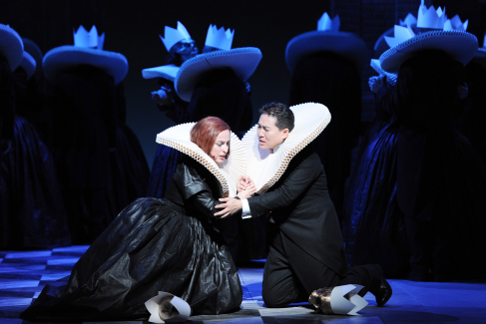 Barbara Dobrzanska as Amelia and Andrea Shin as Gustav III of Sweden with chorus
Barbara Dobrzanska as Amelia and Andrea Shin as Gustav III of Sweden with chorus
I also liked having the conspirators (and male chorus) in the gallows scene decked out in black suits with bowlers and umbrellas looking like surreal Magritte figures in search of a green apple. But then there was an odd, shiny, bright red half-glove that the men wore on the right hand that communicated. . .what? Blood on their hands? A riff on Wacko-Jacko? Who can say? For the titular ball, the all-black look seemed to revert more to Elizabethan time with a contemporary twist, especially for the women who were in shiny, voluminous ball gowns, with silver half masks, pointy white construction paper crowns (again), and oversized white neck ruffs (see “hanging skull,” above).
The imposing set design (Friedrich Eggert) was quite pleasing and often provided an effective psychological environment for the enfolding drama. The basic setting is a ball room, the stage right half all ornate gray marble with moldings and decoration, the stage left side rust colored, bare brick, not unlike the unfinished great rooms of Schloss Herrencheimsee. (This unadorned half is revealed by Oscar and Gustavo during the first extended duet, as they pull down a muslin drape that had been covering it.) A massive banquet table is placed center stage, upon which Oscar and Gustavo conduct no end of frolicsome prancing and dancing.
As the conflicts between characters become apparent, the floor (actually on a three foot platform), splits down the middle (table, too) and opens to a large inverted “V” of a playing space, floor-level center stage. Although there is a bit too much unnecessary “fine-tuning” and futzing with the exact size of this central opening, it does serve to provide a fine focal point for say, Ulrica and her crystal ball. The two levels also allowed for good variety of stage pictures.
Stefan Woinke did a commendable job with a lighting design that showed real imagination and insight. His area lighting established the right moods and kept soloists well illuminated. It was perhaps cheeky to have Oscar snap her fingers to command a spotlight for “his” first number but the moment (and effect) worked. A large circle of pale blue light on the center stage floor was well-used several times, not least of which was during the cat and mouse flirtation in the love duet, culminating in the couple meeting dead center in the light at the climax. I loved the atmosphere created when the ladies’ chorus brought cylindrical, blue tinted votive lights to the séance. And I loved even more when these were re-purposed by placing them around the set for the gallows scene, the spooky desolation suggested further by an overturned half of the banquet table.
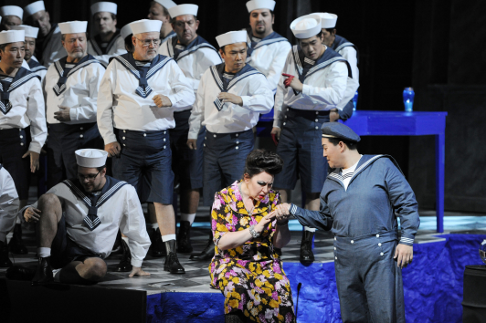 Ewa Wolak as Ulrica and Andrea Shin as Gustav III of Sweden with chorus
Ewa Wolak as Ulrica and Andrea Shin as Gustav III of Sweden with chorus
That half of the table flew to hang menacingly over the heads of Anckarström and Amelia in their big confrontation ‘at home’, the impact of which was marred by a fly man asleep at the rail. When the scene began the front drape went up, but the skull cutout remained and the surtitle screen flew in even lower than that, blocking the action until first the screen, and then the skull got properly readjusted.
Aron Stiehl’s stage direction ran the gamut from amazingly apt (that beautiful circling love duet), to pleasingly competent (arias all had a good theatrical arc), to “what-was-he-thinking?”
When the sailors broke into a dance at the end of Scene One, the effect was a Village People number as staged by St Vitus. Goofy met sloppy. Next scene, the women’s semaphoring hands worked pretty well in a revival meeting sort of way, until the King got the spirit and crossed the front of the stage like he was doing the back stroke and Moonwalk all at once. There were occasional odd uses of levels with principal singers making their way on the stage platform, only to have to jump down to floor level. The chorus boys make lots of distracting noise jumping to earth as Gustavo begins his last solo in Scene One.
Conversely, Mr. Stiehl’s final ball scene is a superb piece of stage craft with excellent movement of the assembled forces, clean choreography, and wonderful focusing of the action. The final duet between the lovers was a model of dramatic tension and the death scene was creditably positioned and lit. . .right up until that dang red yoyo came back.
As Gustavo, Andrea Shin displayed a warm, if not always ‘present’ tenor. Although no announcement was made, I wondered if he might not have been indisposed. There was a persistent light but noticeable gruffness in the passaggio, a subdued lower voice, now and then some ringing top notes, but others that were lightly covered in able to incorporate them into the line. And he tired as the evening went on. It is to Mr. Shin’s credit that he husbanded his resources and finessed his way through the final act, but at least on this occasion, the role did not seem to be an easy fit.
Seung-Gi Jung brought a big, forward-focused voice to Count Anckarström, but the tone could get unwieldy when he went to pulverize a note rather than just sing it securely. When he sang more introspectively, the cantilena was smooth and the voice vibrant. The handsome baritone has a fine sense of theatre, and his anguished utterance of È finita (Eri tu) was heart-wrenching. With so many assets at his command, I urge consideration that a more controlled approach might yield even more impressive results.
The two conspirators were solid and dramatically engaged. Yang Xu (Count Ribbing) showed real promise with his sizable, piercing bass, and as Count Horn, Luiz Molz made a fine contribution. In the small cameo of Cristiano, Andrew Finden took charge of the stage and made every phrase count, with his pleasing baritone and animated presence producing a solid impression.
Emily Hindrichs’ Oscar is as good as I have heard anywhere. Her flexible voice had thrust and clarity, and her vocalization and dramatic commitment were far and away more substantial than the often-encountered chirpy throw-away presentation. An impressive vocal accomplishment indeed. Ewa Wolak is a seasoned and assured singer who knows her voice well and knows her way around Ulrica’s every challenge. Ms. Wolak easily blends her awesome, potent chest register all the way up into a buzzy, searing top that raises gooseflesh as well as the roof. This was a top-drawer portrayal.
And then there is always the Divine Miss D: Barbara Dobrzanksa sings Amelia as well as anyone else on the world’s stages today. Anyone. Else. Her rich, rounded lower voice has just the power and mettle needed to pull off the tricky Ecco l’orrido campo. The upper middle blossoms as it ascends into as expansive a warm spinto as you are likely to encounter. In addition to effortless, thrilling high climaxes, she can scale back her voice to a thread for those melting outpourings of love and despair. The Publikum seems to know well Barbara’s worth, since she was roundly cheered at the call.
In the pit, conductor Johannes Willig had some initial control issues, and the first pages found the orchestra sounding thin and unidiomatic. The chorus also took some time to settle, the basses initially wanting to bound ahead of the beat. But by the end of the first scene, the reading had settled competently into place. Starting with Act Two the Maestro inspired a growing fire that took hold as his assembled forces began cutting loose with some passionate Verdian music making. For future shows, here’s hoping that the fierce commitment of the closing pages could be brought forward to the start.
James Sohre
Cast and production information:
King Gustavo: Andrea Shin; Count Anckarström: Seung-Gi Jung; Amelia: Barbara Dobrzanska; Ulrica: Ewa Wolak; Oscar: Emily Hindrichs; Count Ribbing: Yang Xu; Count Horn: Luiz Molz; Cristiano: Andrew Finden; Judge: Johannes Eidloth; Amelia’s Servant: Jan Heinrich Kuschel; Conductor: Johannes Willig; Director: Aron Stiehl; Set Design: Friedrich Eggert; Costume Design: Doey Lüthi; Lighting Design: Stefan Woinke; Chorus Master: Ulrich Wagner.
image=http://www.operatoday.com/ball_hp2_117.png
image_description=Andrea Shin as Gustav III of Sweden [Photo by Jochen Klenk]
product=yes
product_title=Karlsruhe’s Mixed Blessing Ballo
product_by=A review by James Sohre
product_id=Above: Andrea Shin as Gustav III of Sweden
Photos by Jochen Klenk
Louise Alder, Wigmore Hall
Remarkably assured, and accompanied empathetically and imaginatively by pianist John Paul Ekins, Alder revealed an alluring voice characterised by lyrical charm and astonishing power, particularly at the top; and her vocal prowess was complemented by a sure sense of poetic meaning and musical poetry.
Benjamin Britten’s song cycle On This Island began the programme. Taking their cue from the title of the opening song, ‘Let the florid music praise’, Ekins and Alder relished the Handelian grandeur of the quasi-fanfare rhetoricisms, the soprano’s vocal lines charged with drama and energy, Ekins’ Baroque ornamentations ostentatious and rhythmically propulsive. After the splendour of the first stanza’s agile coloratura displays, the second stanza was more subdued, but lyrical and mellifluous, paralleling the move from public to private world in W.H. Auden’s poetry.
Alder demonstrated a focused and robust tone across the registers, and a flamboyant, theatrical musical presence in this first song. The second, ‘Now the Leaves are Falling Fast’, was more introverted, the irregular ostinato and repeated chords of the accompaniment, coupled with the circling semi-quavers in the voice, creating a tense mood: ‘Arms stiffly to reprove/ In false attitudes of love.’ Yet, the peace and fulfilment intimated in the final verse, ‘None may drink except in dreams’, was fittingly silky and consoling.
In ‘Seascape’ and ‘As it is plenty’ the performers grappled with the rather awkward text settings; the latter, in which Auden presents a social satire mocking the narrowness of bourgeois values, may be witty does not readily lend itself to musical embodiment — but Alder worked hard to convey the ironic vein. However, the even, oppressive chords of ‘Nocturne’ and Alder’s effortlessly lyrical vocal line conveyed a strong understanding of poetic nuance; for the ‘meaning’ is to be found as much in the metrical smoothness of the poetry as in the individual words and this is matched by the regularity of Britten’s music. As the monotone recitation gave way to a progressive rising to the highest pitch, Alder transformed the mood, expressing the move from sleep to consciousness: ‘Calmly til the morning break/ Let him lie, then gently wake.’
Four songs by Richard Strauss followed, beginning with ‘Ich Schwebe’ (I float) in which Alder revealed a rich resonance, if not quite a creamy Straussian sumptuousness. ‘Der Stern’ (The star) showcased the soprano’s wide range and seamless leaps between registers, conveying the tender relationship between the poet-speaker and the star above which ‘waves down here/ it approaches me warmly’ (‘Er nahte mir gern;/ Er Wärmet und funkelt’).
‘Waldesfahrt’ (Woodland journey) was eerily light of touch, the piano’s cascades and evocative diminishment suggesting the shadowy forms ‘nodding through the carriage window’ (‘Kopnickend zum Wagen herein’); the muted ending — as the shadows ‘blend together like mist’ and ‘giggle and dart’ away — was particularly affecting. ‘Schlechtes Wetter’ (Wretched weather) is a vivid setting of Heine’s depiction of quiet family life within and torrential rain without. The performers modulated effectively between the insouciant relaxation of domestic harmony, especially in the swinging waltz-like final stanza, and the dry discord which conveys the dreadful deluge seen through the window-panes.
After the interval came Franz Liszt’s Tre Sonetti di Petrarcha, settings of Petrarch’s sonnets 47, 104 and 123, which tell of the poet’s love for a woman named Laura. Surprisingly Italianate, these songs exploit bel canto idioms — virtuosic display, a wide vocal range, legato melodic lines, climatic phrase structures — and Alder proved equal to all the technical demands. Ekins too mastered the quasi- orchestral accompaniment with ease (the songs were originally published in transcribed form for piano solo). The introduction to ‘Benedetto sia ‘l giorno, e ‘I mese, e l’anno’ (Blessed by the day, the month, the year) had a warm sense of expanse, and the song gained in urgency, an impetuous accelerando towards the close expressing the obsessiveness of the poet’s passion. The strength of Alder’s upper register made a particularly strong impact, and conveyed a sparkling sense of joy, the thrill of the poet’s ‘first sweet pang’ (‘primo dolce affanno’) of love.
During the recitative opening of ‘Pace non trovo’ (I find no peace), Ekins etched the piano lines, particularly the left hand gestures, with real clarity, then found an orchestral resonance in the more operatic aria section ,as Alder’s melody blossomed, culminating in an intense climax cut short by a theatrical silence: ‘Equalmente mi spiace morte e vita’ (death and life alike repel me). Then, the gently undulating accompaniment to ‘I’ vidi in terra angelici costumi’ (I beheld on earth angelic grace) established a sweetness upon which Alder beautifully floated her graceful melody.
After these Austrian and Italian sojourns the performers returned to home territory with three songs by Frank Bridge. ‘Goldenhair’, a setting of Joyce, was characterised by vivid textures and expressive harmonies. ‘When most I wink’, composed when Bridge was a student and the first of his songs to survive, and ‘Love wen a-riding’ were clearly and lightly enunciated by Alder, who communicated the songs’ simple charm engagingly.
The vocal items were framed by two compositions for strings, both dating from the 1920s, impressively performed by the Ligeti Quartet. Béla Bartók’s 4th String Quartet is a taut, sometimes terse work of unceasing compression and concentration, in which outbursts of athletic energy puncture pointillist textures and timbres. The Ligeti Quartet presented a remarkably eloquent reading, controlling the arching five-movement form with intelligence and insight.
The confident tone with which they began the opening Allegro was immediately absorbing; supple melodic lines, energised by rhythmic accents which were rich rather than harsh, intertwined in complex counterpoint, but the textures retained a distinctive clarity as the voices mirrored and answered each other. There was buoyancy and bite, and some agile cello playing from Valerie Welbanks who shaped the pentatonic lyrical fragments expressively. The fleeting flickerings of the muted Prestissimo which follows were wonderfully ethereal; the panoply of coloristic devices — muted harmonics, glissandi, pizzicati — were skilfully negotiated and the players convincingly privileged texture over melody and harmony.
The ‘night music’ of the third movement beautifully contrasted the pianissimo shimmering of the upper strings with the cello’s well-focused exotic melody which meandered in folk-like fashion. Leader Mandira de Saram assumed the melodic thread, her sweet high phrases wistful and melancholy, before second violinist, Patrick Dawkins, interjected with some robust, gutsy G-string colours. The snapping pizzicati of the fourth movement generated a vigorous rustic verve, and this dynamism spilled into the Allegro molto which was an invigorating, impetuous dance, the unpredictable accents building to an emphatic concluding statement of the motto theme which binds the work.
Alban Berg’s passionate, dramatic Lyric Suite closed the recital. The Ligeti Quartet conveyed both the romanticism and modernism of the work, the sweeping range of diverse emotions balanced by a cerebral appreciation of the work’s architecture and language. Since musicologist George Perle discovered in 1976 an annotated copy of the first edition which revealed the precise, autobiographical programme of the work, the emotional highs and lows have been understood within the specific context of Berg’s obsessive passion for Hanna Fuchs-Robettin; but one did not need a narrative key to the musical code in order to appreciate the unfolding drama, so sure was the Ligeti Quartet’s command of the shifts of tempo and intensification of mood: giovale, amoroso, misterioso, estatico, appassionato, delirando, desolato.
The penultimate Presto was fearsomely feverish before the final Largo, in which the players chose to restore the setting of Baudelaire (translated into German by Stefan George) which the dark, foreboding music had originally accompanied. Alder’s focus was startling and the range of colours she found in her lower register impressive; the depiction of the barren polar world over which darkness dwells was weighty and ominous. The chilling climax, as the soprano faced the terror of this night of chaos (‘Und dieser nacht o ein chaos riesengross’) was a moment of extreme theatre: ‘nacht’ rang with piercing intensity, only for Alder to crescendo through the phrase with astonishing power. The falling contours of the final dissolving phrases were attentively shaped but without mannerism, as the string voices slipped away as inexorably as Baudelaire’s slowly unwinding spindle of time.
Claire Seymour
Programme:
Bartók: String Quartet No. 4; Britten: On this Island Op. 11; Richard Strauss: ‘Ich schwebe’, ‘Der Stern’, ‘Waldesfahrt’, ‘Schlechtes Wetter’; Liszt: Tre sonetti di Petrarca; Bridge: ‘Golden Hair’, ‘When most I wink’, ‘Love went a-riding’; Berg: Lyric Suite. Louise Alder, soprano; John Paul Ekins, piano; Ligeti String Quartet. Wigmore Hall, London, Monday 31st March 2014.
image=http://www.operatoday.com/Alder_7788_2.png image_description=Louise Alder [Photo by William Alder] product=yes product_title=Louise Alder, Wigmore Hall product_by=A review by Claire Seymour product_id=Above: Louise Alder [Photo © William Alder]April 9, 2014
Luke Bedford: Through His Teeth, Linbury, Royal Opera House
This packs more into less than an hour than many works which might last five times as long. It’s so concentrated that further hearings will only intensify the respect that it’s due. Bedford, now resident in Berlin, has found astonishing maturity and depth. Through His Teeth is sophisticated, and perhaps a bit above the heads of some, but that’s exactly why Bedford is a true original.
Through His Teeth fires on all cylinders. A, (Anna Devin) a dowdy 30 something looks at fancy cars in a showroom. R (Owen Gilhooly) spots her and chats her up. "I'm not really a car salesman", he says. The tiny orchestra, CHROMA, conducted by Sian Edwards, screams alarm. The small trumpet in C wails like a warning klaxon. The harp's shortest strings are plucked to suggest tight, tense hollowness. An accordion gasps as if its lungs are too constricted to breathe. A doesn't take heed. R picked her out even before she entered the showroom, sensing, perhaps, the vulnerability even she doesn't comprehend. What really draws a sensible girl like A into R's crazy world ? It's not simply that he's good in bed. Almost from the start she knows something's wrong. R's paranoid and thinks he's under surveillance. A assumes he's MI5. So it's OK for her to accept flowers from him if he's taken them from someone he says he's just killed ? Morally, she too, is compromised.
Distorted values, distorted reality. The designs (Becs Andrews) capture the psychological dislocation implicitly in David Harrower's deceptively simple text. Walls slide across the stage, dividing it into tightly framed compartments. Sam Meech's videos fragment, offering mutiple different perspectives, even, perhaps that of the sinister surveillance person is watching him. R controls A because she lets herself get cut off from the world around her. Yet. the walls of her "prison" are pierced weith holes which she could look through if she wanted to. This is the Faustian pact she's made with R. Like Mephitopheles he can offer her the wildest dreams imaginable but she must sell her soul.
The clarinet in B flat sings a poisoned melody, like a snake charmer's instrument. The cello is played so its strings reverberate their whole length, like a snake, flexing its muscles sensuously, like a snake falling, willingly, into hypnosis. The percussionist beats brushes, quietly replicating a failing heartbeat. Bedford creates sounds that are so intriguing that the listener is drawn into an invisible trap, almost against one's will. With abstract music, Bedford recreates extreme psychological complexity. Through His Teeth isn't just about sex. Manipulative people create cults around themselves.
A sinks so deeply into R's psychosis that her sister (Victoria Simmonds, playing multiple roles) who lives in the real world, finds a way to trap him. R is put into prison. Gilhooly walks as if he';s in chains we cannot see. Brilliantly economic direction by Bijan Sheibani. Watch this director - he's very good. Chains we cannot see: perhaps that sums up the horrifying nature of these mind games. A meets another of R's women, (also Simmonds), a bag lady who blames herself for not being good enough to join the MI5 of R's imagination. Modern Mephistopheles prey on their victim's hidden weaknesses, sucking them into a web of their own making.
At the end, the TV interviewer (Simmonds again) asks A, who is now technically "free", what she would do if if she were to meet R again. The question is put gently.. A's response seems non committal, but Bedford's music suggests that A knows, deep in her heart, that she's do it all over again. The ending is powerful , all the more because it's so chillingly understated. Bedford's Through His Teeth is a major work, which needs to be carefully contemplated.
Anne Ozorio
image=http://www.operatoday.com/THROUGH%20HIS%20TEETH%20SC1_0547%20ANNA%20DEVIN%20AS%20A%2C%20OWEN%20GILHOOLY%20AS%20R%2C%20ANNA%20DEVIN%20AS%20A%2C%20VICTORIA%20SIMMONDS%20AS%20SISTER%20%28C%29%20STEPHEN%20CUMMISKEY.png
image_description=Anna Devin as A, Owen Gilhooly as R,and Victoria Simmonds as Sister [Photo © ROH / Stephen Cummiskey]
product=yes
product_title=Luke Bedford: Through His Teeth, Linbury, Royal Opera House
product_by=A review by Anne Ozorio
product_id=Above: Anna Devin as A, Owen Gilhooly as R,and Victoria Simmonds as Sister [Photo © ROH / Stephen Cummiskey]
April 8, 2014
Powder Her Face, ENO
With its scuffed floors, grubby whitewash and exposed pipes, this dimly lit ‘contemporary arts venue’ has all the charm of an underground car park. Sadly, it has the acoustic of one too, which makes for problems a-plenty for the cast of Thomas Adès’ Powder Her Face.
The opera depicts the decline of Margaret, Duchess of Argyll, the infamous British socialite whose shameful ill-repute followed a 1963 divorce case against her second husband, the 11th Duke of Argyll, featuring indecent photographs and scandalous accusations. For English National Opera’s new production in the infernal cave of Ambika P3, the audience is seated in raked wooden tiers, on three sides of the central stage. The concept is clear: director Joe Hill-Gibbins has made us part of the show, first tabloid rubberneckers, greedily relishing the Duchess’s crimes and misdemeanours, then courtroom observers self-righteously witnessing her disgrace and punishment.
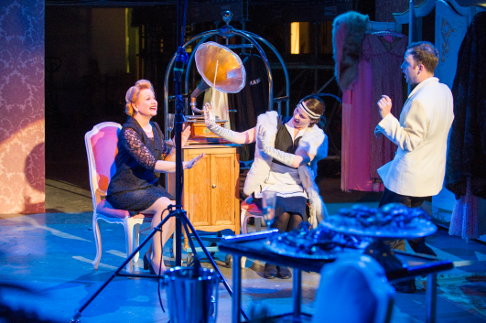 Amanda Roocroft as the Duchess, Clare Eggington as the Maid and Alexander Sprague as the Electrician
Amanda Roocroft as the Duchess, Clare Eggington as the Maid and Alexander Sprague as the Electrician
In this spirit of voyeurism — Jay Scheib’s New York City Opera production of February 2013 adopted a similar approach — cameras and cameramen are ubiquitous, salaciously snapping the Duchess’s moral transgressions. And, we are morbidly complicit; as becomes more explicit in Scene 6, when Maid and Electrician, in the guise of scandal-seeking plebs (baseball caps, outsize sunglasses and lurid green anoraks) take their places amid the audience in the courtroom gallery. (In fact, it seems rather ironic that an opera that satirises both aristocratic debauchery and the grim prurience of the hypocritical Establishment and baying populace, should itself have become a succès de scandale (Classic FM considered it unsuitable for transmission) for its operatic fellatio.
Tacky polaroids and web cams flash on the wall high above us, and serve a useful practical purpose, delineating the plot in the absence of surtitles. For, despite their best efforts, the casts’ consonants are unable to cut through the venue’s reverberating boom. Hill-Gibbins and Movement Director Imogen Knight thoughtfully position the protagonists around the traverse, but inevitably as soon as a back is turned the words vanish.
Adès’ score thus has to tell the tale, and the panoply of parodic pastiches that it offers certainly paints deft mood pictures. Accordion, saxophone, even fishing reel, are all called into service to delineate the Duchess’s downfall and the world of hedonist indulgences that she forgoes. The selected instrumentalists of the orchestra of English National Opera who form the chamber ensemble produce fantastic playing of verve and wit. Conductor Timothy Redmond is an experienced proponent of this score and draws forth both its jazzy sleaziness and lugubrious anxiety. Unfortunately, placed to one side of the alley stage, the loud instrumental brassiness is rather unyielding, another over-powering obstacle to the singers’ audibility.
Designer Ultz dangles a paste chandelier aloft and summons a suitably dissolute air of shabby chic. The Duchess’s boudoir is a fading monument to sugary excess: salmon pink drapes, plump padded cushions and silky fleck wallpaper. But, it’s all more sordid than sensual; louche rather than luxurious. The scenes move swiftly, charting in flashback and by flashbulb the Duchess’s dissipations. But, as the dozen silent actors who rush around with measuring tape and microphone, gathering evidence and filming the unsavoury proceedings, the stage area becomes ever more cluttered: to plush chairs and dishevelled double bed are added hotel dining room (with palm trees and towering plates of crustacean cuisine), mauve enamel bathtub (with gold dolphin taps) — not to mention a multitude of looming lenses. It all begins to resemble Tracey Emin’s ‘My Bed’, the detritus charting the embarrassing carnage of the Duchess’s past. Indeed, the various leftovers of a life do indeed become labelled exhibits during the court proceedings in Scene 6.
Amid this dingy décor and disarray, the four principals are uniformly superb. Taking the multi-roles of Maid-Confidant-Mistress-Journalist and Electrician-Lounge Lizard-Waiter-Delivery Boy, soprano Claire Eggington and tenor Alexander Sprague respectively surmount the technical challenges with expertise and energy. Eggington assails the score’s stratospheric gabbling with aplomb; her intonation is unfailingly spot on, and her agile, bright coloratura never shrill — it’s just a pity that she is defeated by the resounding boom.
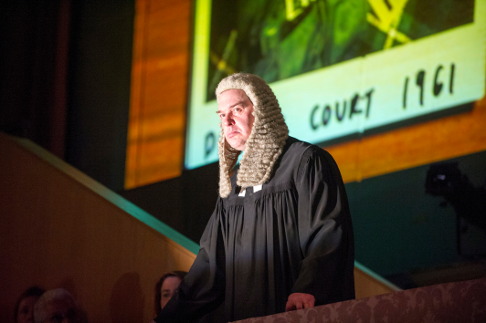 Alan Ewing as the Hotel Manager
Alan Ewing as the Hotel Manager
Entering from the staircase, with all the pomposity of a drag queen diva, the fur-coated, bewigged Sprague demonstrates a theatrical exuberance which is matched by his engaging, flexible tenor. Clean of tone and varied of colour, Sprague is an intelligent performer, and proved highly alert to the musical and dramatic comedy.
Bass Alan Ewing, as Hotel Manager-Duke-Judge, is astonishing as he employs every shade and nuance of his capacious voice to convey character and mood. His appearance as Judge, a black spectral monster presiding aloft, was a wonderful coup de théâtre and this aria the musical highlight of the evening. Ewing’s magisterial pronouncements in a sinister low register accompanied by cynical brass fanfares were chilling (they reminded me of Janáček’s Sinfonietta which, oddly, was used as the theme tune for Crown Court, a Granada Television drama series broadcast during the 1970s!). Ewing can float a falsetto too; controlling wide registral leaps with technical assurance, he created an unease which was enhanced by instrumental glissando squeaks. Adès’ score in this scene has a visceral intensity. The Judge’s verdict that ‘She is a beast to an exceptional degree’ is accompanied by a savage orchestral pounding, evidence perhaps of the veracity of his conclusion that the Duchess is ‘insatiable, unnatural and altogether fairly appalling’, but also of the shocking patriarchal oppression and abuse latent in his declaration that the ‘Duke has no stain on his character. I pity him for the mistake he has made, which frankly any of us might make’.
Similarly striking was Ewing’s appearance as the Hotel Manager in the final scene (set in 1990), when he was coldly dismissive of the Duchess’s distress as her life is dismantled, the debris piled high. Ewing’s wonderful descending glissando, plumbing the depths, was complemented by the emotions suggested by the orchestral shadows, the unsettling sequences of chords evoking the elusive ‘interview chords’ of Britten’s Billy Budd.
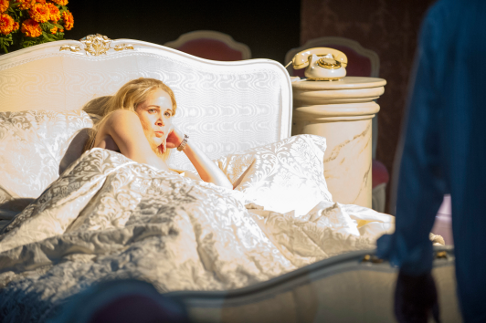 Claire Eggington as the Maid
Claire Eggington as the Maid
In the title role, Amanda Roocroft was totally committed, offering an heroic performance — not least when forced to wear a black lace body suit and when performing the notorious sex act. Presented throughout in aging decline, she watched scenes from her past play out before her, creating a sense of emotional estrangement. Roocroft’s Duchess had both hauteur and weariness. Her dismissive response to public condemnation — ‘So that is all. I am judged. I do not care’ — was powerfully eloquent in that it conveyed the sincerity of her contempt, enhanced by searing trumpet sneers at the close. Perhaps the closest we come to feeling pity for the monstrous Duchess is in Scene 7 (set in 1970) when the shamed aristocrat’s disdainful rejoinder, ‘I never touch money. … I have no need to. Cash is wearying and cash is soiling’, is juxtaposed with a visual crystallisation of self-delusion at the end of the scene, as the Duchess desperately tears up her enormous, unpaid hotel bill. She is surrounded by men in various states of undress, stationed motionless, as string glissandi and the garish green glow create a mood of unreality and alienation. The whining instrumental mockery builds through a startlingly strident crescendo; she is both defiant and defensive.
Roocroft’s breakdown in the final scene was shocking. A sole chair remains, a symbol of loneliness which is enhanced by the cold open intervals of clarinets moving in parallels, the lines lagging rhythmically. As she frantically slaps rouge upon her lips, the cosmetic stick breaks, like the illusions which have sustained her; she violently smears and daubs as the brass section’s curling lines deride, the vacuity of her life painfully embodied in the empty, broken atomiser of her favourite perfume, ‘Joy’.
Adès’ technical precocity — he was just 24-years-old when the opera was composed in 1995 — and easy mastery of parody and pastiche reminds one of Benjamin Britten, to whom the composer was frequently compared during his early career. In Powder Her Face, the relentless parodies become a bit wearisome — the stylistic sophistication is impressive but there is an emotional emptiness which begins to irk.
Although musically worlds apart, it seems to me that there are similarities between Adès’ opera and Britten’s Death in Venice, with its composite roles and demeaned aging aristocrat; but whereas we are moved by Gustav von Aschenbach’s humiliations, vulnerability and despair, it is hard to feel pity for someone whose monstrous utterances betray a vicious racism and arrogant snobbery. When the Duchess tells a journalist, ‘One never sees a white face, not in the street, not now … Black men buy houses/ Jews go everywhere’, we are hardly endeared. One might say that Adès’ score and its ‘star’ both have a heartless brittleness — much like the modern cult of celebrity. The echoes of the Duchess of Malfi — ‘I am a Duchess still’, Margaret of Argyll superciliously retorts to the onlookers who cluster outside the court to witness her mortification — seem out of place when the speaker has so little dignity and nobility. She is driven by poison rather than passion; her final ‘mad scene’ has little pathos, for she is shredded by a self-destructive solipsism not external oppression, and the dry piano chords seem to mock the woman who has only pride and conceit to blame for her demise.
That said, Roocroft and the other principals work unremittingly and show indefatigable versatility. Ultimately, both the Duchess and her drama may seem shallow, ugly and worthless, the opera merely a trifle depicting the idle rich behaving badly. Yet, if there is little of moral value, Powder Her Face is certainly an entertaining jeu d’esprit; and these high-quality performances deserve a more helpful venue.
Claire Seymour
Cast and production information:
The Duchess: Amanda Roocroft; Maid: Claire Eggington; Electrician: Alexander Sprague; Hotel Manager: Alan Ewing; Actors: Trevor Goldstein, Stewart Heffernan, Stephen Pucci; Hotel Staff: Patrick Achegani, George Bishop, David Black, Michael Black, Jessica Morris, Mark Shevlin, Daniel Soton, Adam Tripp; Director, Joe Hill-Gribbins; Conductor: Timothy Redmond; Designer: Ultz; Lighting Designer: Adam Silverman; Assistant Designer: Mark Simmonds; Movement Director: Imogen Knight; members of the ENO Orchestra: leader, Janice Graham. Ambika P3, University of Westminster London, Wednesday 2nd April 2014.
image=http://www.operatoday.com/ENO%20Powder%20Her%20Face%202014%20Amanda%20Roocroft%20%28c%29%20Richard%20Hubert%20Smith.png image_description=Amanda Roocroft as the Duchess [Photo by Richard Hubert Smith] product=yes product_title=Powder Her Face, ENO product_by=A review by Claire Seymour product_id=Above: Amanda Roocroft as the DuchessPhotos © Richard Hubert Smith
April 1, 2014
Iphigénie Fascinates in the Pfalz
That the orchestra and chorus performed magnificently, tirelessly, must be attributed to the exceptional inspiration from conductor Markus Bieringer. The young Maestro elicited the best playing I have yet heard from this resident orchestra, and he was able to turn his forces on a dime as the tempi and emotional content changed frequently, from recitative to choral statements, to dances, to miniature ariosos, to full-blown scenas, he served up each musical moment with precision, depth and stylistic acumen. Ulrich Nolte’s chorus was also meticulously prepared: accurate, impassioned, and totally committed to the drama. Maestro Bieringer’s concentration and command of Gluck’s richly complex score never faltered, making this reading one of the most inspired (and inspiring) operatic performances in my recent memory.
In the taxing title role, Adelheid Fink offered an assured and persuasive interpretation. Her plangent soprano is freely produced, and her slightly grainy timbre was well suited to the French style. Moreover, she was able to meet all the wide-ranging demands requiring varied vocal delivery, as well as suitably embody the shifting emotional state of the troubled heroine. Iphigénie is a Big Sing, and Ms. Fink’s distinguished, indefatigable achievement proved an auspicious role assumption.
Melanie Lang is a real company asset, showcased here as a musically well-schooled Clitemnestre. Her pliant lyric mezzo easily encompasses the role’s requirements, and when Ms. Lang gets up a head of steam she can effectively introduce just the right weight and hint of steel (especially at the top), to fully command the ear as well as the stage. Bernd Valentin brought a towering presence to Agamemnon. His burly, burnished baritone was deployed with skill and conviction and he maintained admirable control even during the king’s most anguished outbursts. He also nearly peeled the paint off the ceiling with one hurled, high invective that was as astounding for its security as its sheer power. Mr. Valentin’s was a masterful portrayal.
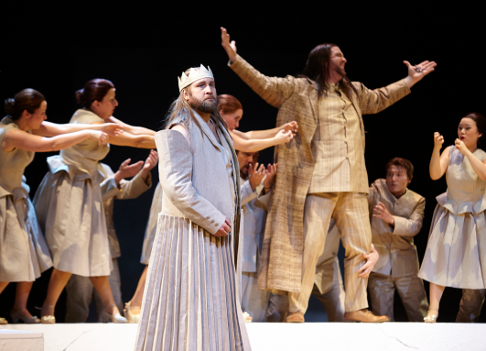 Bernd Valentin as Agamemnon and Michael Hauenstein as Kalchas with chorus
Bernd Valentin as Agamemnon and Michael Hauenstein as Kalchas with chorus
Bernhard Berchtold sports exactly the kind of tenor needed for Achille: sweet-voiced, comfortable well above the staff, meaty enough to fill the hall, yet flexible enough to serve the more florid aspects of the piece. An early climactic high note almost came to grief (and did not thanks to sheer willpower), but once past that hurdle Mr. Berchtold’s singing just seemed to go from strength to strength, complemented by a stage deportment that was sincere and natural. Michael Hauenstein’s Calchas proved to be a fine complement to Valentin’s Agamemnon. Mr. Hauenstein’s voice is a bit rounder, a bit more modulated, but every bit as ‘present.’ His devious characterization, smooth phrasing, and sly vocal inflections ably embodied Calchas’ bent for crafty manipulation. In the smaller role of Arkas, Alexis Wagner showed off an orotund bass of substantial weight and accomplished training.
The visuals of the physical production were exceptionally rewarding. Smaller theatres with fewer resources sometimes make the mistake of trying to be too avant garde, even garish, but here we were blessed with a well-coordinated, finely detailed, cleanly appealing look from a talented design team.
Anna Kirschstein’s setting features a large arch that is lying in state, toppled by an unseen force. The sturdy construction allows for it to function as a seating area, stage platform, barrier, pathway, and other multi-functional purposes. The playing space is backed by a handsome, neutral drop made up of a collage of earth-toned vertical slats of wood. This “wall” can also split to reveal a cyclorama, trees, projections and a profusion of stage smoke to accent the story.
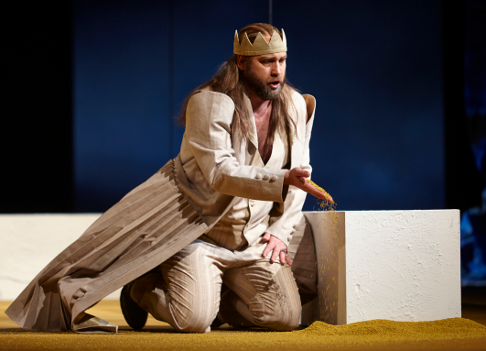 Bernd Valentin as Agamemnon
Bernd Valentin as Agamemnon
In Act Two when the wedding is about to take place, the massive structure flies up, forming a ceiling of sorts, while leaving a fragmented piece of “ruin” on the ground. The underside of the suspended edifice is cleverly outfitted with internal lighting that floods down on center stage. Harald Zidek’s lighting design is generally very good, and he makes excellent use of cross fades and specials. There are also exciting effects that find the cast momentarily back-lit against the cyc. I would only hope that Mr. Zidek could clean up a few key moments when people were soloing in the dark.
Stephan Rinke’s fanciful costumes seemed loosely based on classical styles but re-interpreted with visual riffs on the silhouette. Unusual folds and pockets figure prominently in Mr. Rinke’s concept. Clitemnestre’s gown was particularly characterful and inventive, with sassily inverted pleats almost suggesting a farthingale effect. The chorus ladies’ knee-length peasant attire had smaller, similar ruffles around the waist. The royal men were generally in long jackets, almost tunics. Stephan chose exciting fabrics in variations of browns and creams, which incorporated complex textures and degrees of refinement that were helpful in powerfully establishing the characters’ station and relationships. Even Agamemnon’s obligatory pointed Euro-production crown was made of appropriate fabric, and all attire was exceptionally well-tailored and carefully accessorized. Hair, wigs and make-up were stylish and well-considered, and there was an imaginative use shoes that found the leading lady changing out (or abandoning) several pairs as she goes through character transitions. Too, I liked the contemporary red hair weaves that were shared by Clitemnestre and her daughter. The overall look was a classy, unified, timeless vision which proved to be a handsome workable concept as well as a bold artistic statement.
Stage director Benjamin Schad for the most part created blocking motivated by the character developments. He crafted numerous memorable pictures, such as an extended introspective moment with Iphigénie on the ground in fetal position; a cat and mouse game that communicated well the lovers growing trust and attraction; a tense confrontation scene that underscored the crackling tension between Agamemnon and Calchas; and a particularly moving segment that found the daughter cradling and comforting her distraught mother. I applaud Mr. Schad for moving the chorus with clarity and purpose, all the while allowing them to focus on singing cleanly. They were so well rehearsed that I could forgive the few times that the groupings yielded more calculated choral posturings than dramatically involved characters.
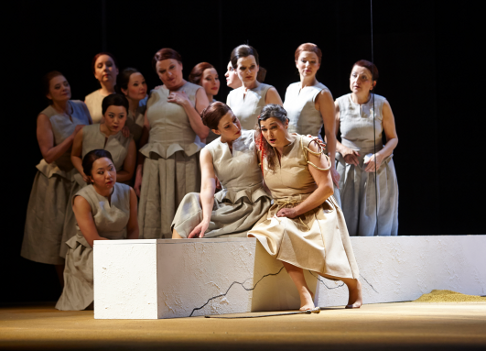 Adelheid Fink as Iphigenie with women's chorus
Adelheid Fink as Iphigenie with women's chorus
Very infrequently, strange positioning threatened dramatic effectiveness. Early in the second half, creation of stage picture trumped visibility of the star, and Iphigénie spent an extended scene far upstage right, behind a seated (and non-singing) Clitemnestre, when the scene would have worked as well with the star prominently down right. Minor carping aside, the production scored an affecting ‘coup de theatre’ with a tacked on ending not of Gluck’s creation.
During the original finale toy swords are passed out and the cast play acts at going to war as is presaged in the text. Then, to added instrumental music the toy swords are collected and placed in a pile like so much firewood at the front of the stage where Iphigénie and Clitemnestre are perched on the lip. Then as the chorus sings a unison militant anthem, realistic rifles are passed out, and the assembled forces exit upstage, ultimately in silence, marching relentlessly into a brutal conflict, backlit through swelling smoke, as the two leading women stare helplessly forward into the void during a slow fade to black. I don’t usually approve of tinkering with the composer’s intent, but since none of the original music was violated (merely added to), this was a stunning final impression.
The smallish audience clearly knew that they had just experienced something very special and lavished the performers with extended, heartfelt acclaim. Indeed, the only bad thing to report is the attendance figures. Ticket sales to date have resulted in small houses. Perhaps it is because the title is unfamiliar. Too bad, because Iphigénie en Aulide is a significant achievement and deserves to be seen. It is not often we get a chance to see this piece at all, much less in such a thrilling performance.
James Sohre
Cast and production information:
Agamemnon: Bernd Valentin; Clitemnestre: Melanie Lang; Iphigénie: Adelheid Fink; Achille: Bernhard Berchtold; Calchas: Michael Hausenstein; Arcas: Alexis Wagner; Conductor: Markus Bieringer; Director: Benjamin Schad; Set Design: Anna Kirschstein; Costume Design: Stephan Rinke; Lighting Design: Harald Zidek; Chorus Master: Ulrich Nolte.
image=http://www.operatoday.com/Iphigenie%2008.png
image_description=Adelheid Fink as Iphigenie and Melanie Lang as Klytämnestra [Photo by Thomas Brenner]
product=yes
product_title=Iphigénie Fascinates in the Pfalz
product_by=A review by James Sohre
product_id=Above: Adelheid Fink as Iphigenie and Melanie Lang as Klytämnestra
Photos © Thomas Brenner